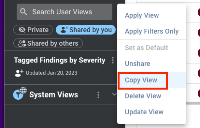Saved Views: Overview
This article summarizes the key features of saved views.
Saved views combine applied filters with list view settings. This feature allow you to store different views of your data for easy future access. Depending on the available settings, you can store the
- Applied Group By
- Applied filters
- Pinned Columns
- KPIs configurations
- Column order, sort, and width
- Rows per page
- Position of the left filter pane (open or collapsed)
- Position of KPI bar (open or collapsed)
- Row density settings (compact/cozy/comfortable)
(Note that Group By views lack KPIs. Additionally, some pages like Groups and the Vulnerability KB list views lack the Group By feature.)
This feature also provides clients the ability to tailor page settings for new users. For example, organizations that set SLAs based on Severity may want new users to see findings prioritized by the Severity column. Other organizations might want to add scanner-specific fields or filters.
v2 list views support this feature. The article List View v2 Saved Views Update discusses how saved views differ from saved filters.
Types of Views
The platform allows you to categorize user-created views based on whether you have created them or others have created them:
- Only you can see and manage private views.
- Other users can see views shared by you.
- You can apply views shared by others.
System views let you filter based on specific topics like Workflow Type or well-known threats documented by researchers and industry authorities.
Under Shared by others, you will see the views Client Defaults and System Defaults:
- Client Defaults: Every new user starts out with Client Defaults as the default view for the page. Users with the appropriate privileges can edit these.
- System Defaults: The System Defaults provides the platform default settings for a page. No one can edit them.
Applying Views and View Filters
By default, clicking the view card applies only the filters associated with the view. Users can apply the view through the options menu on the view card. Users can change the default click behavior for a view card through the Users Settings page. For more information, visit the article on applying views and view filters.
Creating a View
For instructions on how to create a view, visit the article on creating a view.
Updating a View
For instructions on how to modify a view, visit the article on updating a view.
Sharing a View
By sharing a view, you make it visible to other users within the same client. For more information, visit the article on sharing a view.
Setting a Default View
The default view normally loads the first time that you visit a page after logging in. (Exceptions include using a deep link or clicking a link on a dashboard.) The system will prevent you from setting a view with a Group By as your default. For more information, visit the article on setting a default view.
Copying a View
You can copy a view by selecting Copy View from the options menu on the view card. While you will need to provide a unique title for the view, this action allows you copy every other aspect of the view.
Deleting a View
You can permanently delete a view if you own it. You can find the option to delete a view in the options options menu on the view card.
Managing Client Defaults
Users with the appropriate privilege can modify the Client Defaults. For more information, visit the article on managing client defaults.
Resetting a List View to Its Default State
When modifying a list view, you may desire to restore the default system settings. For more information, visit the article on resetting a list view to its default state.

